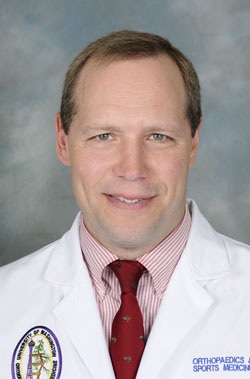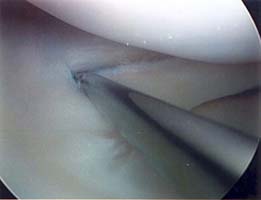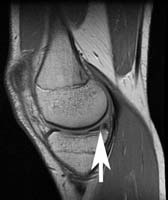Arthroscopic Meniscus Repair: Minimally invasive surgery to repair torn knee cartilage
Overview
Arthroscopic meniscus repair is an outpatient surgical procedure to repair torn knee cartilage. The torn meniscus is repaired by a variety of minimally invasive techniques and requires postoperative protection to allow healing. Physical therapy is useful to regain full function of the knee, which occurs on average 4-5 months after surgery.
Symptoms of Torn Meniscus
Torn knee cartilage generally produces pain in the region of the tear and swelling in the knee joint. These symptoms are made worse with pivoting motions, squatting, and vigorous activities. Torn meniscus fragments can get caught in the knee joint and cause catching sensations. If a large enough fragment becomes lodged between the bearing surfaces, the knee may ‘lock’ and become unable to be fully bent or extended.
For more detailed information on symptoms and diagnosis, please see our article on torn meniscus.
Goal of Arthroscopic Meniscus Repair
The goal of meniscus surgery is to preserve healthy meniscus tissue. A meniscus tear requires a blood supply to heal. Only the outer third portion of the meniscus has blood supply to enable healing of a tear. Repairs are generally limited to this peripheral region of the meniscus.
Many types of meniscus tears occur in the region of the meniscus without adequate blood supply for healing. Meniscus removal is generally recommended for tears to regions of the meniscus without blood supply. Please see arthroscopic meniscectomy for more information.
Surgical Options for Torn Meniscus
Meniscus tears can be treated by meniscus removal (meniscectomy), meniscus repair, or in unusual circumstances, meniscus replacement. Since the goal of surgery is to preserve healthy meniscus, meniscus repair is attempted when the tear is repairable.
Meniscectomy, removal of the damaged meniscus tissue, has good short term results but leads to the development of arthritis ten to twenty years later.
Meniscus repair also has good results, but has a longer recovery time than meniscectomy and is limited to tears which are amenable to repair.
Meniscus replacement is considered for young, active patients who have previously had most of their meniscus removed, and develop pain in the area without having advanced degenerative changes to the articular (gliding surface) cartilage. Please see meniscus replacement for additional information.
Effectiveness
When performed by an experienced surgeon, meniscus repair is highly successful , with good results in approximately 90% of patients. Any knee that is injured has a higher likelihood of developing arthritis. A successful repair slows the development of arthritic changes. Factors associated with higher rates of meniscus healing include repair within 2 months, more peripheral tear location, and concomitant ACL reconstruction.
Possible benefits of arthroscopic meniscus repair
The meniscus is an important structure for load transmission and shock absorption in the knee. The knee is subjected to up to 5 times body weight during activity, and half this force is transmitted through the meniscus with the knee straight, and 85% of the force goes through the meniscus with the knee bent ninety degrees. Loss of the meniscus increases the pressure on the articular (gliding) cartilage, which leads to degenerative changes. A successful meniscus repair preserves meniscus tissue and mitigates these changes.
Who should consider arthroscopic meniscus repair?
Even though the recovery is longer for a meniscus repair than for a meniscectomy, any repairable meniscus should generally be repaired. Meniscus repair is considered when:
- the patient is healthy and wishes to remain active,
- the patient understands the rehabilitation, and accepts the risks of surgery,
- the meniscus tear is located in the periphery of the meniscus,
- the meniscus tissue is of good quality, and
- the surgeon is experienced in meniscus repair
Surgical Animation
The surgical animation below is an example of the arthroscopic meniscus repair procedure. Not all surgical cases are the same. The animation below is only an example to be used for patient education.
Not all surgical cases are the same, this is only an example to be used for patient education.
Non-Surgical Treatments
Medications
Anti-inflammatory medications, taken by mouth or injected directly into the knee, can be useful to reduce the pain and swelling symptoms associated with meniscus tears, but do not improve healing. No medications or nutritional supplements have been scientifically documented as beneficial for meniscus healing.
Exercises
Quadriceps strengthening exercises are useful to reduce swelling and restore normal muscular control to an injured knee. They useful to reduce symptoms and speed rehabilitation.
What happens without surgery?
In the best case scenario, the tear would heal back in the appropriate place, achieving the same result as a meniscus repair. This is very unlikely. In the worst case scenario, a repairable meniscus would tear further and become unrepairable, and fragments of torn meniscus would injure the articular (gliding) cartilage leading to accelerated arthritis.
About Arthroscopic Meniscus Repair
Urgency
Surgery for a meniscus tear is not an emergency. Arthroscopic meniscus repair is an elective procedure that can be scheduled to minimize disruption of patients’ lives. Results are maximized by repairing meniscus tears within the first two months of injury.
Risks
All surgery has risks. There is likely nothing you could imagine could go wrong that has not gone wrong at some time. That being said, meniscus repair is a safe procedure with a complication rate of 1.3%. The most common complications are injuries to skin nerves, the vast majority of which resolve without additional procedures by three months post surgery. Injury to larger nerves or blood vessels is rare, as are blood clots. Knee stiffness, infections, and other problems are uncommon, but can occur. An experienced surgical team uses special techniques to minimize these risks, but unfortunately they cannot be completely eliminated.
Managing risk
The most effective treatment of complications is prevention. For example, the risk of infection is decreased by giving antibiotics prior to surgery, and the risk of blood clots is decreased by using anti-embolism stockings. If infection does occur, repeat arthroscopy to remove infected tissue and debris, in conjunction with antibiotics for six weeks is generally effective. If blood clots occur, blood thinners are used for three months to decrease the chance of clots growing or breaking off and traveling to the lungs. Knee stiffness can often be managed with physical therapy and braces, but may require arthroscopic releases to restore motion. Since most complications can be effectively managed when identified promptly, if patients have questions or concerns about the post-operative course, the surgeon should be informed as soon as possible.
Preparation
Since arthroscopic meniscus repair is an elective procedure, the patient’s situation can be optimized for successful surgery. There should be someone to help at home for the first several days since mobility will be impaired. There should be no current infections. The knee should have no sores or scratches. The knee should not be shaved on the day of surgery or the day preceding surgery. Cutting down or stopping smoking will decrease risk of infection and blood clots, and improve healing. Airplane flights should not be scheduled within the first five days following surgery to decrease chances of blood clots. Dental work often releases bacteria into the blood, so should not be scheduled in the first six weeks after surgery. If unavoidable, antibiotics around the time of the dental work may decrease infection risk.
Timing
Meniscus repair is optimally performed within the first two months after meniscus tear to maximize meniscus healing. Walking on a knee that is ‘locked’ (does not fully straighten) may damage the meniscus further and make a tear unrepairable. Squatting should be avoided prior to surgery, as that may displace a piece of meniscus into the joint and cause ‘locking’.
Costs
The surgeon’s office should provide a reasonable estimate of the surgeon’s fees, the hospital fee, the anesthesia fee, and the degree to which these should be covered by the patients insurance.
Surgical team
Arthroscopic meniscus repair is an advanced surgical skill that should be performed by an orthopedic surgeon trained in arthroscopic techniques. The surgery should be performed in a hospital or outpatient surgical center that handles a large volume of arthroscopic knee surgeries.
Finding an experienced surgeon
Surgeons who have had fellowship training in sports medicine have received additional advanced training in arthroscopic techniques such as meniscus repair. The operation is best performed by a surgeon with an interest and experience in arthroscopic meniscus repair. Surgeons with these qualifications can be located through university schools of medicine, and are often members of specialty societies such as the American Orthopedic Society for Sports Medicine and Arthroscopy Association of North America.
Facilities
Arthroscopic meniscus repair is an outpatient surgery that is performed in a hospital or outpatient surgical center. A center that handles a large volume of arthroscopic knee surgeries has experienced nurses and therapists to assist patients recover.
Technical details
After the anesthetic is administered and knee examined, a tourniquet is placed on the upper thigh and the thigh is secured to the table in a padded limb holder. The knee and lower leg are cleansed and draped and a diagnostic arthroscopy is performed. A diagnostic arthroscopy is a thorough examination of the inside of the joint with a camera hooked up to viewing screens. The instruments are approximately 5mm in diameter and are inserted through three or four 1cm incisions around the knee. One incision is for sterile saline inflow, used to improve visualization within the joint. A systematic inspection of the knee documents any problems, which can also be addressed. The meniscus tear is identified and probed with a small metal hook. The size, pattern, location, stability, and tissue quality of the meniscus tear are assessed, and decision made about repair versus removal of the damaged tissue. The opposing edges of the meniscus tear prepared to enhance healing using a small rasp or motorized shaver. If the blood supply to the tear is questionable, several techniques can be used to improve healing including; placing a blood clot in between the two parts of the tear, creating small vascular access channels in the peripheral rim of meniscus, or making the joint lining bleed. The meniscus is then secured back in place with one or more of a variety of devices including; suture, an absorbable tack, or a meniscus repair device. Sutures require additional small incisions to tie down.
Anesthetic
Arthroscopic meniscus repair can be safely performed under general or spinal anesthetic. In addition, local anesthetic is injected into the knee and incision sites. The patient is encouraged to discuss preferences with the anesthesiologist prior to surgery.
Length of arthroscopic meniscus repair
Arthroscopic meniscus repair generally takes between an hour and an hour and a half. Depending on how much other surgery is necessary to take care of other problems in the knee, the time may be a bit more or less.
Pain and pain management
Arthroscopic meniscus repair is moderately painful. Because more soft tissue surgery is performed, it is more painful than a standard arthroscopy, but less painful than a ligament reconstruction or another procedure that requires drilling holes through the bone. Local anesthetic is used during surgery to minimize pain, but patients generally have a swollen, painful knee for the first three days after surgery, which is manageable with oral narcotic and anti-inflammatory pain medication.
Use of medications
Oral anti-inflammatory medication is taken by mouth on a schedule, and narcotic pain medicine is taken by mouth as needed. Patients require narcotic pain medications an average of 2-5 days after surgery.
Effectiveness of medications
The combination of narcotic and anti-inflammatory pain medication produces highly effective pain relief with minimal side effects. Good pain control is a balance between effectiveness and side effects. Since all narcotic pain medicine can cause nausea and be constipating, drinking plenty of fluid and taking a stool softener after surgery can decrease these problems.
Important side effects
Narcotic pain medications can cause drowsiness, slowness of breathing, difficulty emptying the bladder and bowel, nausea, vomiting and allergic reactions. Patients who have substantial narcotic medications or alcohol in the recent past may find that usual doses of pain medication are less effective. For some patients, balancing the benefit and the side effects of pain medication is challenging. Patients should notify their surgeon if they have had previous difficulties with pain medication or pain control.
Hospital stay
Arthroscopic meniscus repair is an outpatient procedure. After surgery, the patient spends one to two hours in the recovery room, and is discharged to home with a friend or family member.
Hospital discharge
After arthroscopic meniscus repair, the patient generally has a cryocuff and a knee brace. The cryocuff is cold, compression device, that consists of a bladder around the knee and a cooler for ice a water. Using gravity to empty and fill the bladder, the knee can be kept cool to minimize swelling and decrease pain. The brace keeps the leg straight. Depending on the pattern of the tear, full weight-bearing in the brace may be permitted immediately after surgery. Taking it easy the first two days after surgery, with the limb propped up when sitting helps keep swelling to a minimum, and will actually speed recovery. During this time, pumping the ankle up and down is recommended to improve blood flow in the leg. Specific post operative instructions will be reviewed prior to discharge.
Convalescent assistance
Even though patients go home after arthroscopic meniscus repair, they will appreciate some assistance for the first several days after surgery. Driving is not recommended until a patient is comfortable off all narcotic pain medications.
Physical therapy
The three early postoperative rehabilitation goals are; get the knee out fully straight, decrease swelling, and regain quadriceps muscle control. Patients are encouraged to do straight leg raises in the brace immediately after surgery. The brace is used to walk with the knee in extension for six weeks. Range of motion is generally started soon after surgery from 0-90 degrees, without any weight-bearing during motion. The brace is unlocked at six weeks and weaned off when good quadriceps control is demonstrated. Motion is increased as tolerated at six weeks, but deep squats are avoided until 12 weeks. Low impact type activities such as swimming and exercise machines are encouraged at 12 weeks, with advancement to cutting and pivoting sports generally at 16 weeks. The assistance of a physical therapist is very helpful in achieving a rapid full recovery.
Rehabilitation options
The Sports Medicine Center has experienced physical therapists, who regularly guide patients through meniscus repair rehabilitation. Since much of the work of rehabilitation is done at home, the surgeon, patient and therapist are partners in a successful outcome. Since many patients come a distance for our expertise, we have developed working relationships with many therapy clinics in the surrounding area to make therapy more convenient.
Usual response
Patients are generally satisfied with the progress made during rehabilitation, and often feel ready to do more than allowed during each phase. Adherence to this protocol has led to successful outcome. If the exercises seem particularly difficult or painful, the patient should contact the therapist or surgeon.
Risks
This is a safe rehabilitation program with minimal risk.
Duration of rehabilitation
Return to sports requires the ability to perform sports specific drills at competition speed. Depending on the rigors of the sport, the preoperative condition, associated injuries, and other individual factors, return to a chosen sport generally takes four to five months. Rehabilitation should continue until the patient’s athletic goals are achieved.
Returning to ordinary daily activities
Patients are generally able to get back to activities of daily living three to four days after arthroscopic meniscus repair. These activities will initially be performed while wearing a brace. Help at home for the first several days after surgery is beneficial.
Long-term patient limitations
After full rehabilitation and recovery, patients have no limitations. However, if significant articular (gliding) cartilage injury or degeneration is noted at the time of diagnostic arthroscopy, high impact type sports are discouraged to slow the progression of arthritis.
Costs
Since much of the rehabilitation is done at home, rehabilitation is cost-effective. The surgeon and therapist should be able to provide the usual cost of the rehabilitation program.
Summary of arthroscopic meniscus repair for meniscus tear
- In the hands of an experienced surgeon, arthroscopic meniscus repair is effective outpatient surgical procedure to repair torn knee cartilage.
- The torn meniscus is repaired by a variety of minimally invasive techniques and requires postoperative protection to allow healing.
- Physical therapy is useful to regain full function of the knee, which occurs on average 4-5 months after surgery.

Last updated: January 24, 2013

